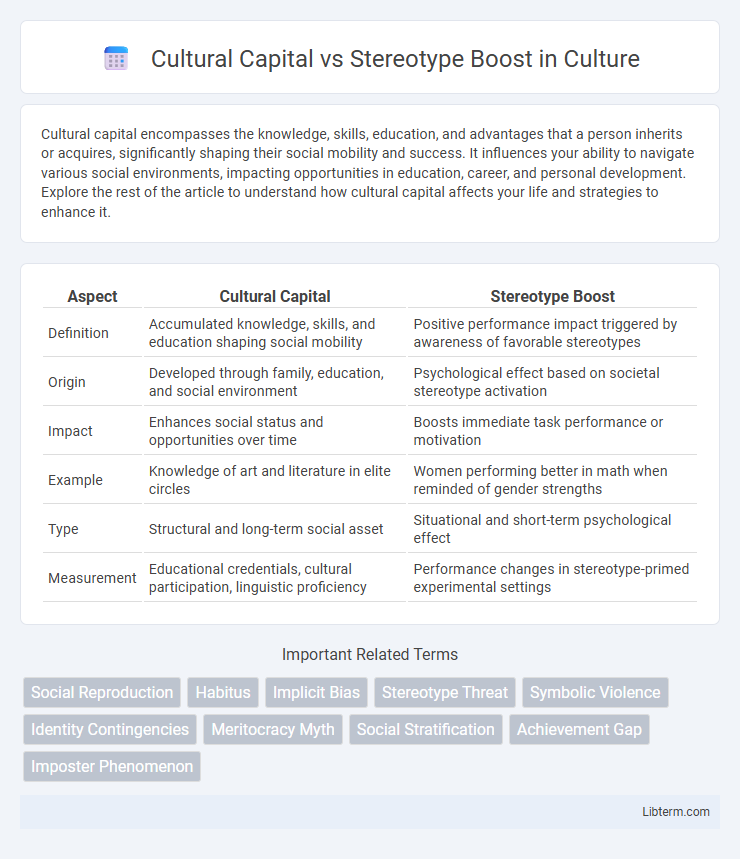Cultural capital encompasses the knowledge, skills, education, and advantages that a person inherits or acquires, significantly shaping their social mobility and success. It influences your ability to navigate various social environments, impacting opportunities in education, career, and personal development. Explore the rest of the article to understand how cultural capital affects your life and strategies to enhance it.
Table of Comparison
| Aspect | Cultural Capital | Stereotype Boost |
|---|---|---|
| Definition | Accumulated knowledge, skills, and education shaping social mobility | Positive performance impact triggered by awareness of favorable stereotypes |
| Origin | Developed through family, education, and social environment | Psychological effect based on societal stereotype activation |
| Impact | Enhances social status and opportunities over time | Boosts immediate task performance or motivation |
| Example | Knowledge of art and literature in elite circles | Women performing better in math when reminded of gender strengths |
| Type | Structural and long-term social asset | Situational and short-term psychological effect |
| Measurement | Educational credentials, cultural participation, linguistic proficiency | Performance changes in stereotype-primed experimental settings |
Understanding Cultural Capital
Understanding cultural capital involves recognizing the non-financial social assets that influence an individual's social mobility, such as education, style of speech, dress, and cultural knowledge. Unlike stereotype boost, which refers to performance improvement due to positive stereotypes, cultural capital shapes opportunities by aligning with dominant societal norms and values. This form of capital plays a crucial role in academic achievement, professional success, and social integration by providing individuals with the tools and credentials valued in a given culture.
Defining Stereotype Boost
Stereotype boost refers to the phenomenon where individuals perform better on tasks when they are aware of positive stereotypes about their social group, enhancing their confidence and motivation. This contrasts with cultural capital, which encompasses non-financial social assets like education, intellect, and style of speech that influence social mobility. Understanding stereotype boost highlights how positive social perceptions can directly impact cognitive performance and achievement.
Origins and Influences of Cultural Capital
Cultural capital originates from social environments where individuals gain skills, knowledge, and behaviors valued by society, deeply influenced by family background, education, and social class. It shapes how individuals navigate institutions and social settings, providing advantages that often reinforce societal inequalities. Stereotype boost emerges when positive stereotypes enhance performance, contrasting with cultural capital's broader acquisition of societal resources and privileges.
Mechanisms Behind Stereotype Boost
Stereotype boost occurs when positive stereotypes about a group's abilities enhance individual performance through increased confidence and reduced anxiety. This mechanism contrasts with cultural capital, which relies on accumulated knowledge, skills, and behaviors acquired from one's environment. Psychologically, stereotype boost activates motivation and self-efficacy by aligning with societal expectations, thereby improving cognitive function and task engagement.
Impact on Educational Achievement
Cultural capital enhances educational achievement by providing students with language skills, knowledge, and behaviors valued by the school system, leading to higher academic performance and increased access to resources. Stereotype boost positively influences achievement when students are aware of favorable stereotypes about their group, which can increase confidence and motivation during academic tasks. Both concepts significantly affect educational outcomes but operate through distinct psychological and social mechanisms impacting student engagement and success.
Cultural Capital in Social Mobility
Cultural capital plays a crucial role in social mobility by equipping individuals with the skills, knowledge, and behaviors valued in society, thus facilitating access to better educational and occupational opportunities. Unlike stereotype boost, which temporarily enhances performance based on positive group stereotypes, cultural capital provides sustained advantages through inherited or acquired cultural competencies. This sustained advantage enables individuals from higher cultural capital backgrounds to navigate social institutions more effectively and improve their socioeconomic status over time.
Stereotype Boost and Group Performance
Stereotype boost occurs when positive stereotypes about a group enhance individual and collective performance in relevant tasks, leveraging group identity to increase motivation and confidence. This phenomenon contrasts with cultural capital, which refers to the accumulation of knowledge, behaviors, and skills that enable social mobility. Research shows that stereotype boost can significantly improve group performance by reinforcing positive expectations and reducing anxiety during evaluations.
Interplay Between Cultural Capital and Stereotypes
The interplay between cultural capital and stereotype boost significantly influences individual performance and social mobility, as cultural capital provides access to valued knowledge, skills, and behaviors that align with dominant societal norms. Stereotype boost occurs when positive expectations linked to a group's identity enhance performance, often amplifying the benefits of cultural capital in educational or professional settings. Understanding this dynamic reveals how cultural capital can both reinforce and challenge stereotypes, shaping opportunities and outcomes within diverse social contexts.
Challenging Stereotypes with Cultural Capital
Cultural capital plays a pivotal role in challenging stereotypes by equipping individuals with the knowledge, skills, and social assets necessary to defy preconceived notions and limitations. This form of capital supports individuals in navigating dominant cultural contexts, enabling them to present multifaceted identities that counteract simplistic or negative stereotypes. Empowering marginalized groups through education, social networks, and culturally relevant experiences fosters stereotype resistance and promotes more equitable representations.
Building Equity Through Awareness and Action
Cultural Capital enhances individual success by leveraging social assets like education, skills, and cultural knowledge, while Stereotype Boost improves performance through positive group-related expectations. Building equity requires recognizing these dynamics to create inclusive environments that value diverse backgrounds and dismantle biases. Proactive awareness and targeted action foster equal opportunities, enabling marginalized groups to access resources and thrive without prejudice.
Cultural Capital Infographic

 libterm.com
libterm.com